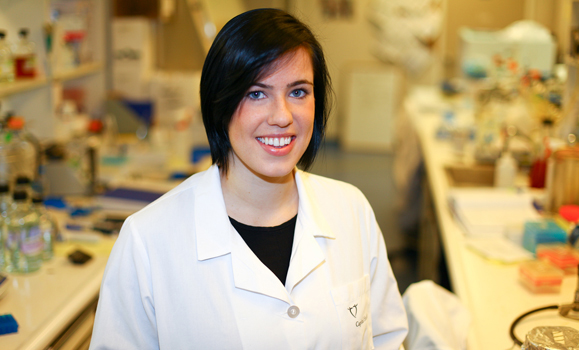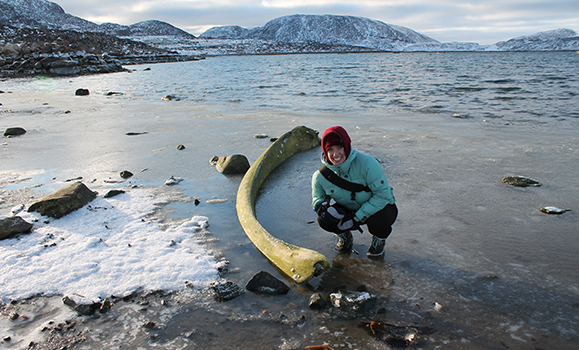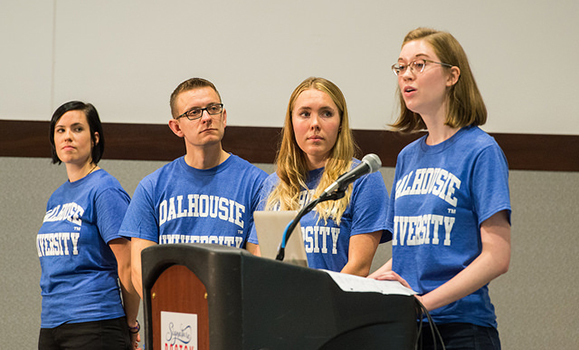From Cape Dorset, Nunavut to Boston, Massachusetts, Leah Johnston has had a whirlwind fourth year, travelling throughout North America sharing the power of education, science and her undergraduate microbiology research.
Johnston, originally from Guelph, Ontario, became interested in pursuing a Bachelor of Science in Microbiology and Immunology after taking a high school course that covered disease and bacteria. Then, she began her time at –¬º”∆¬¡˘∫œ≤ ø™Ω±÷±≤• in the ‚Äî an intense first-year science program with a multidisciplinary approach and a focus on scientific research.
“It taught me a lot,” says Johnston. “Doing the research project in the second semester really helped me become interested in research… It made me appreciate science so much more.”
Fast forward to two years later and Johnston was employed as a summer research assistant with John Rohde’s lab in the Department of Microbiology and Immunology. The following summer, she was back in the Rohde Lab with a coveted Natural Sciences and Engineering Council of Canada (NSERC) (USRA).

Drawn to the North
Because Johnston held an NSERC USRA and is a member of the Six Nations of the Grand River First Nation, she was also eligible for the (AANSE). The program promotes interest and participation in natural sciences and engineering by bringing Aboriginal students and fellows on visits to Aboriginal communities and schools.
Becoming an NSERC Aboriginal Ambassador piqued Johnston’s interest, so Dr. Rohde set her up with Bob Huish in Dal’s Department of International Development Studies —a professor whose research has examined the high incidence of tuberculosis in Nunavut. With guidance from Dr. Huish and some helpful contacts in Nunavut, Johnston put together a proposal for the grant. A few months later she found herself explaining microbiology, immunology and tuberculosis to students from grades five to 12 in Cape Dorset and Iqaluit.
“I want to be a doctor, a family practitioner,” explains Johnston, who returned from Nunavut at the end of October. “I’ve always thought about working in Northern communities, but thought I’d be in Northern Ontario. I fell in love with the place [Cape Dorset] and I can see myself living there,” she said, adding later that she learned family life in the community is difficult.
“Maybe I’ll be a positive factor in people’s lives and hopefully help implement change,” said Johnston. “After my presentation to a sixth-grade class, the teacher told me one of her students said he wants to be a scientist when he grows up. I thought that if I could influence just one person, then I succeeded.”

Leah in Nunavut, posting with a whale bone. (Provided photo)
Engineering a team
Leadership comes naturally to Johnston. Before travelling to Nunavut, she was president of Dal’s first-ever team to participate in the International Genetically Engineered Machine Foundation’s (iGEM) Giant Jamboree — an international synthetic biology research competition among students and their faculty supervisors. The Dal team consisted of students from Microbiology, Chemistry and Agriculture. Their goal was to genetically engineer a naturally occurring compound in blueberries that pack a mean nutritional and disease-fighting punch.
With support from Dr. Rohde in the Faculty of Medicine, Vasantha Rupasinghe in the Faculty of Agriculture and Sophia Stone in the Faculty of Science, Dal’s iGEM team got to work, taking two summers to prepare the research they would later present at the Jamboree in Boston.
“It’s said that synthetic biology will be a $300-billion industry by 2030,” says Dr. Rohde. “In my [Microbiology] courses, we cover a number of topics and synthetic biology is one students are most interested in because it’s new.”
Dr. Rohde explains synthetic biology as the process of creating a “bug” in the lab with “workhorse” microbes — bacteria and yeast. The intention is to genetically engineer the “bugs” to produce beneficial compounds, like antioxidants, that are only found in nature and difficult to produce in labs using chemistry.
“The most effective way we get antioxidants now is through whole-plant cultivation,” explains Johnston, adding that poor crop outputs and environmental factors can be costly and unpredictable. She says synthetic biology is a way to create a different mode of getting antioxidants.

Leah (far left) and her Dal iGEM teammates (L to R): Eric Pace, Emma Price, Emma Finlayson-Trick. (iGEM photo)
iGEM students had to work with nine different genes in their project, though one that Johnston was responsible for was challenging. Instead of being able to copy that gene’s DNA, which ended up being impossible, she had to create the DNA from scratch using a method called the Gibson assembly.
“Leah was the first person in the [Microbiology and Immunology] department to successfully use the Gibson assembly,” says Dr. Rohde. “And she’s an undergrad!”
presented well at the Giant Jamboree in Boston and though they didn’t walk away winners, Johnston feels they gained just as much as any winner would.
“It’s was a really valuable experience and we all had a great time,” says Johnston.
Johnston is set to graduate with her degree this spring and hopes to begin medical school after another visit to Nunavut and a bible study program in the United Kingdom.
Dal‚Äôs participation in the iGEM Giant Jamboree was funded by the Department of Microbiology¬Ýand Immunology, the Faculties of Science, Medicine and Agriculture, the Office of the President, the –¬º”∆¬¡˘∫œ≤ ø™Ω±÷±≤• Science Society and the –¬º”∆¬¡˘∫œ≤ ø™Ω±÷±≤• Student Union.

